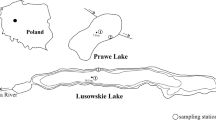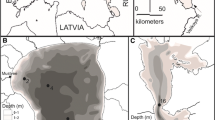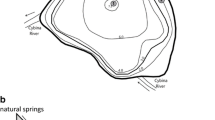Abstract
Lake Ringsjön did not respond with decreased algal production following a substantial reduction in external phosphorus loading. This is typical of many shallow lakes which for decades have received excessive amounts of nutrients. The inertia is due to large amounts of phosphorus (P) stored in sediments and biota, causing internal phosphorus loading. Much of this phosphorus is thought to be released from the organic-rich profundal sediments. In Lake Ringsjön, only one third of the total bottom area is covered by such sediments, the rest being dominated by sand and silt. In the profundal sediments bulk P content was not exceptionally high (approximately 2 mg P·g DW−1), while the pore water phosphate concentrations, especially in Sätofta Basin, were very high, indicating large potential for phosphorus release to the water. This is also indicated by the large proportion of Fe- and Al-bound P in the sediments of Sätofta Basin. Although there are no direct quantifications of phosphorus release from the sediments in Lake Ringsjön, measurements of phosphorus concentrations in the water mass as well as budget calculations for the three basins clearly show a high capacity for internal loading. Phosphorus concentrations generally increase during summer, when external additions are minimal. Until 1980, the annual external phosphorus addition to Lake Ringsjön greatly exceeded the output, showing that the lake was an efficient phosphorus trap. Since then, input and output have been balanced, but in recent years signs that the lake is once again retaining phosphorus on an annual basis are evident. There are marked differences between the three basins, with Western Basin generally retaining phosphorus, while the upstream Eastern Basin and Sätofta Basin during the 1980s often exported phosphorus. It is not possible to evaluate the effects of the fish biomanipulation on the internal loading of phosphorus from the sediment.
Similar content being viewed by others
References
Ahlgren, I. et al., 1979. Lake metabolism – Studies and results at the institute of limnology in Uppsala. Arch. Hydrobiol. Beih. Ergebn. Limnol. 13: 10–30.
Andersson, G., W. Granéli & J. Stenson, 1988. The influence of animals on phosphorus cycling in lake ecosystems. Hydrobiologia 170: 267–284.
Bergman, E., 1997. Ringsjön i Skåne – restaurering genom cyprinidreduktion – effekter av fiskreduktionen (Lake Ringsjön in Scania – rehabilitation through cyprinid reduction – effects from the fish reduction). Dept. of Limnology, Lund University, 77 pp. (In Swedish).
Bergman, E., L.-A. Hansson & G. Andersson, 1999. Biomanipulation in a theoretical and historical perspective. Hydrobiologia 404: 53–58.
Björk, S. et al. 1979. Lake management – Studies and results at the institute of limnology in Lund. Arch. Hydrobiol. Beih. Ergebn. Limnol. 13: 31–55.
Boström, B., J. M. Andersen, S. Fleischer & M. Jansson, 1988. Exchange of phosphorus across the sediment–water interface. Hydrobiologia 170: 229–244.
Boström, B., M. Jansson & C. Forsberg, 1982. Phosphorus release from lake sediments. Arch. Hydrobiol. Beih. Ergebn. Limnol. 18: 5–59.
Cooke, G. D., E. B. Welch, S. A. Peterson & P. R. Newroth, 1993. Restoration and management of lakes and reservoirs, second edition. Lewis Publishers, Boca Raton, 548 pp.
Cullen, P. & C. Forsberg, 1988. Experiences with reducing point sources of phosphorus to lakes. Hydrobiologia 170: 321–336.
van der Molen, D. T. & P. C. M. Boers, 1994. Influence of internal loading on phosphorus concentration in shallow lakes before and after reduction of the external loading. Hydrobiologia 275/276: 379–389.
Enell, M., 1983. Sedimentens betydelse i Ringsjöns eutrofiering (The importance of the sediments for the eutrophication of Lake Ringsjön). Institute of Limnology, University of Lund, 110 pp. (In Swedish).
Enell, M., 1985. Ringsjön – ekosystem i förändring 1984: Ringsjöns struktur och funktion 1984 samt förändringar under perioden 1975–1984 (Lake Ringsjön – Ecosystem under change 1984: The structure and function of Lake Ringsjön 1984 and changes during the period 1975–1984). Mellanskånes Planeringskommitté and Dept. of Limnology, Lund University, 94 + 15 pp. (In Swedish).
Enell, M., 1986. Ringsjön – ekosystem i förändring 1985: Tabelloch figursammanställning för 1985 samt kortfattad beskrivning av sjöns struktur och funktion samt förändringar under perioden 1975–1985 (Lake Ringsjön – Ecosystem under change 1985: Tables and Figures for 1985 and a short description of the structure and function of Lake Ringsjön and changes during the period 1975–1985). Mellanskånes Planeringskommitté and Institute of Water and Air research (IVL), 73 pp. (In Swedish).
Enell, M. & M. Eriksson, 1987. Ringsjön – ekosystem i förändring 1986: Tabell-och figursammanställning för 1986 samt kortfattad beskrivning av sjöns struktur och funktion samt förändringar under perioden 1975–1986 (Lake Ringsjön – Ecosystem under change 1986: Tables and figures for 1986 and a short description of the structure and function of Lake Ringsjön and changes during the period 1975–1986). Mellanskånes Planeringskommitté and Institute of Water and Air research (IVL), 82 pp. (In Swedish).
Enell, M. & M. Eriksson, 1988. Ringsjön – ekosystem i förändring 1987 – Beskrivning av sjöns struktur och funktion 1987 samt förändringar under 1975–1987 (Lake Ringsjön – Ecosystem under change 1987 – Description of the structure and function of Lake Ringsjön 1987 and changes during 1975–1987). Mellanskånes Planeringskommitté and Institute of Water and Air research (IVL), 104 pp. (In Swedish).
Enell, M. & J. Henriksson, 1989. Ringsjön – ekosystem i förändring 1988 – Beskrivning av sjöns struktur och funktion 1988 samt förändringar under 1975–1988 (Lake Ringsjön – Ecosystem under change 1988 – Description of the structure and function of Lake Ringsjön 1988 and changes during 1975–1988). Mellanskånes Planeringskommitté and Institute of Water and Air research (IVL), 138 pp. (In Swedish).
Enell, M. & J. Henriksson, 1990. Ringsjön – ekosystem i förändring 1989 – Beskrivning av sjöns struktur och funktion 1989 samt förändringar under 1975–1989 (Lake Ringsjön – Ecosystem under change 1989 – Description of the structure and function of Lake Ringsjön 1989 and changes during 1975–1989). Mellanskånes Kommunalförbund and Institute of Water and Air research (IVL), 138 pp. (In Swedish).
Enell, M. & J. Henriksson, 1991. Ringsjön – ekosystem i förändring 1990 – Beskrivning av sjöns struktur och funktion 1990 samt förändringar under 1975–1990 (Lake Ringsjön – Ecosystem under change 1990 – Description of the structure and function of Lake Ringsjön 1990 and changes during 1975–1990). Mellanskånes Kommunalförbund and Institute of Water and Air research (IVL), 133 pp. (In Swedish).
Enell, M. & J. Henriksson-Fejes, 1992. Ringsjön – ekosystem i förändring 1991-Beskrivning av sjöns struktur och funktion 1991 samt förändringar under 1975–1991 (Lake Ringsjön – Ecosystemunder change 1991 – Description of the structure and function of Lake Ringsjön 1991 and changes during 1975–1991). Mellanskånes Kommunalförbund and Institute of Water and Air research (IVL), 125 pp. (In Swedish).
Enell, M., J. Fejes & A. Henriksson, 1993. Ringsjön – ekosystem i förändring 1992 – Beskrivning av sjöns struktur och funktion 1992 samt förändringar under 1975–1992 (Lake Ringsjön – Ecosystem under change 1992 – Description of the structure and function of Lake Ringsjön 1992 and changes during 1975–1992).Mellanskånes Kommunalförbund and Institute of Water and Air research (IVL), 111 pp. (In Swedish).
Enell, M., J. Fejes & A. Henriksson, 1994. Ringsjön – ekosystem i förändring 1991–1993 – Beskrivning av sjöns struktur ochfunktion 1991–1993 samt förändringar under 1975-1993 (LakeRingsjön – Ecosystem under change 1991–1993 – Description of the structure and function of Lake Ringsjön 1991–1993 and changes during 1975–1993). Mellanskånes Kommunalförbund and Institute of Water and Air research (IVL), 152 pp. (In Swedish).
Enell, M. & J. Fejes, 1995. Ringsjön – ekosystem i förändring 1994 – Beskrivning av sjöns struktur och funktion 1994 samt förändringar under 1975–1994 (Lake Ringsjön – Ecosystem under change 1994 – Description of the structure and function of Lake Ringsjön 1994 and changes during 1975-1994). Mellanskånes Kommunalförbund and Institute of Water and Air research (IVL), 112 pp. (In Swedish).
Enell, M., J. Fejes & C. Williams, 1996. Ringsjön – ekosystem i förändring 1995 – Beskrivning av sjöns struktur och funktion 1995 samt förändringar under 1975–1995 (Lake Ringsjön – Ecosystem under change 1995 – Description of the structure and function of Lake Ringsjön 1995 and changes during 1975–1995).Mellanskånes Kommunalförbund and Institute of Water and Air research (IVL), 86 pp. (In Swedish).
Enell, M., J. Fejes & C. Williams, 1997. Ringsjön – ekosystem i förändring 1996 – Beskrivning av sjöns struktur och funktion 1996 samt förändringar under 1975–1996 (Lake Ringsjön – Ecosystem under change 1996 – Description of the structure and function of Lake Ringsjön 1996 and changes during 1975–1996).Mellanskånes Kommunalförbund and Institute of Water and Air research (IVL), 86 pp. (In Swedish).
Enell, M. & S. Löfgren, 1988. Phosphorus in interstitial water: method and dynamics. Hydrobiologia 170: 103–132.
Granéli, W. 1979. The influence of Chironomus plumosus larvae on the exchange of dissolved substances between sediment and water. Hydrobiologia 66: 149–159.
Granéli, W. & D. Solander, 1988. Influence of aquatic macrophytes on phosphorus cycling in lakes. Hydrobiologia 170: 245–266.
Hamrin, S. F., E. Bergstrand, G. Cronberg, A. Persson, P. Romare & J. Strand, 1993. Sjörestaurering genom cyprinidreduktion – Ringsjöns utveckling under perioden 1987 – 1992 (Lake rehabilitation through cyprinid reduction – The development of Lake Ringsjön 1987 – 1992). Dept. of Limnology, Lund University and Swedish Fisheries Research Board, Drottningholm, 28pp. (In Swedish).
Hamrin, S. F., T. Soler, M. Eriksson, J. Svensson, H. Linge, G. Cronberg & P. Romare, 1998. Från sediment till fisk – en översiktlig studie av Vombsjöns ekosystem 1994–95 (From sediment to fish – an outline of the Lake Vombsjön ecosystem 1994–95). Fiskeriverket Rapport (1998) 1: 77–105. (In Swedish).
Hamrin, S., 1999. Planning and execution of the fish reduction in Lake Ringsjön. Hydrobiologia 404: 59–63.
Hansson, L.-A., M. Enell & E. Bergman, 1999. Lake Ringsjön: its catchment area, its history and its importance. Hydrobiologia 404: 1–7.
Hieltjes, A. H. M. & L. Lijklema, 1980. Fractionation of inorganic phosphates in calcareous sediments. J. Envir. Qual. 9: 405–407.
Holtan, H., L. Kamp-Nielsen & A. O. Stuanes, 1988. Phosphorus in soil, water and sediment: an overview. Hydrobiologia 170: 19–34.
Kairesalo, T., L. Tuominen, H. Hartikainen & K. Rankinen, 1995. The role of bacteria in the nutrient exchange between sediment and water in a flow-through system. Microb. Ecol. 29: 129–144.
Kamp-Nielsen, L., 1997. Nutrient dynamics and modelling in lakes and coastal waters. In K. Sand-Jensen & O. Pedersen (eds), Freshwater Biology – Priorities and Development in Danish Research, G. E. C. Gad Publishers, Copenhagen: 116–137.
Pettersson, K., B. Boström & O.-S. Jacobsen, 1988. Phosphorus in sediments-speciation and analysis. Hydrobiologia 170: 91–101.
Phillips, G., R. Jackson, C. Bennett & A. Chilvers, 1994. The importance of sediment phosphorus release in the restoration of very shallow lakes (The Norfolk Broads, England) and implications for biomanipulation. Hydrobiologia 275/276: 445–456.
Ryding, S.-O., 1983a. Ringsjöområdet – ekosystem i förändring (Lake Ringsjön – ecosystem under change). Mellanskånes Planeringskommitté and Dept. Of Limnology, Uppsala University, 159 pp. (In Swedish).
Ryding, S.-O., 1983b. Vattenkvalitet och ämnestransport – Ringsjön och dess tillflöden 1975–1980 (Water quality and solute transport – Lake Ringsjön and its tributaries 1975–1980). MellanskånesPlaneringskommitté and Dept. Of Limnology, Uppsala University, 82 pp. (In Swedish).
Schöllhorn, E. & W. Granéli, 1997. The importance of increasing N/P ratios for phytoplankton biomass and species composition in an oligotrophic lake. Verh. int. Ver. Limnol. 26: 615–620.
Svensson, J. M., E. Bergman & G. Andersson, 1999. Impact of cyprinid reduction on the benthic invertebrate community and implications for increased nitrogen retention. Hydrobiologia 404: 99–112.
Verner, B., 1994. Control of external loading – Lake Ringsjön, Sweden. In M. Eiseltová (ed.), Restoration of Lake Ecosystems-a Holistic Approach, IWRB Publication 32: 103–108.
Author information
Authors and Affiliations
Rights and permissions
About this article
Cite this article
Granéli, W. Internal phosphorus loading in Lake Ringsjön. Hydrobiologia 404, 19–26 (1999). https://doi.org/10.1023/A:1003705520085
Issue Date:
DOI: https://doi.org/10.1023/A:1003705520085




